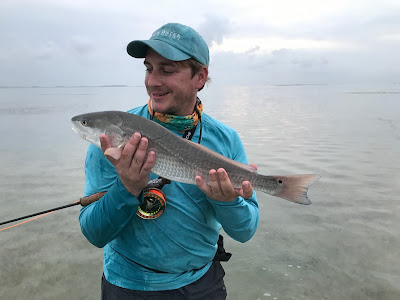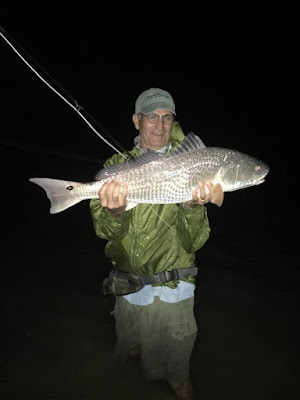Ryan always wants to fish. He reminds me of myself, when I used to come home from Virginia once a year to fish for two or three weeks, spending every day on the water till late afternoon. My family grew accustomed to seeing me sunburned and sleepy, falling asleep on the sofa, dead tired. My brother would fish with me as often as he could, but he would inevitably return to the boat way ahead of me, and sit there watching and waiting for me to expend my last bit of energy for the day. And now it was my turn to face the enthusiasm of my son, who will wade as long and as far as time will allow, positing theories about what might lie just beyond reach that justify endless excursions into areas usually devoid of life, but not always.
I couldn't leave the house without Rosie. I'd taken her to the vet the day before, and the doctor had drained some pouches of fluid and sent them away for biopsy. Maybe cancer, the doctor said. Rosie is 13, and each trip to the Bay could be her last, but it's hard to leave her home when she stands in the doorway at 4 am, wagging her tail, knowing full well what's up. I pretend that all she wants is a treat, but her tail keeps wagging after the second bit of fake bacon. It's the boat, stupid, not the silly treats that she can have at any time of the day or night. So I call out to Julie in the dark, "I'm taking her." And then I move the passenger seat back to make room for her, and we leave for the bay, perhaps for the last time together. Who knows the time allotted?
Ryan and I had disagreed the night before on when we should plan to launch. The forecast called for 80 degrees before midday, but the small print said it would be 49 at daybreak. Much too cold for my old hands, which grow numb when it's below 65. Reynaud's syndrome, I think. Anyway, I suggested that we launch around 7:30. Ryan thought we'd be competing with a crowd, but I didn't mind that as much as the chill factor of predawn air. I won since I'm still the nominal daddy, and there's no tie breaker. Later, he admitted that I had been right: Hardly anyone was at the launch, and neither of us was looking forward to the cold ride.
We went north into Paytons Bay, thinking that birding could be on. But no, there were no birds working. The wind was supposed to be 3 mph at dawn, but it was closer to 10, and the north wind made for a slight chop that drowned out any visible signs of fish. Running in and out of Paytons, we turned south toward Cullens Bay, about 12 miles to the south. "We need more sun before we can see fish," I yelled above the Yamaha's throaty roar, and Ryan nodded. It was really cold, and my hands were so numb that I could not tie a knot if my life depended on it.
As we approached the entrance to south Cullens Bay, Rosie began acting strangely. She started circling the console, going round and around while Ryan and I looked at each other. What the hell? Then she climbed onto the front deck, walked up to the bow, and got ready to go overboard in 12 feet of water. "She's got to poop," I yelled. Spinning the boat around, I sped down Cullens channel, and ran aground on a spoil island. Rosie jumped off the bow into thick mud, and I followed, sinking up to my knees in soft mud. Rosie ran 10 feet, and gave way to a wet one. I walked over, apologizing, while she looked up with gratitude in her eyes. An unmistakeable look.
Ryan and I were happy to take a break from the long run. So I walked with Rosie onto the spoil island, half expecting to see a peregrine falcon sitting on one of the man-made hills of dredge tailings. Then we retraced our steps through the thick mud and covered the boat with it.
We poled the skiff along the spoil banks on the outside of Cullens Bay, and had a couple of good shots at very large reds. Ryan missed them and proceeded to punish himself verbally for his imprecision. I have found that it's not much use to say, "You should have caught that fish," because self-loathing never improves the next cast. I genuinely don't hold it against anyone who misses a good shot, because there's more learning to be had from near misses than the catch that gets posted all over social media, where the considerable influence of sheer luck and the need for further refinement is quickly forgotten amidst the "likes" and thumbs up.
There were tailing reds to be seen, but they were intermittent, and the low wind and the white clouds on the horizon conspired to create a glare on the water, preventing us from seeing the abundant reds and trout that we had seen when running. It was frustrating, and Ryan's memory of failure grew in stature until his mood had hardened. So after two rather lengthy, fruitless wades, we headed east for the sand.
Oh my, the sand was a sight to behold. There was no moisture in the air, so the Padre dunes were brightly lit against the azure sky, and the water was crystalline. Turtle grass sprigs covered the sand, and the water seemed only a foot deep or less given its perfect clarity. Actually, the water was knee-deep when we started seeing reds fleeing from the boat. And then we saw our first of many schools of 50 plus reds, and we could go no further. Coming off of plane, we staked the boat and stepped into the warming water. Rosie leapt from the bow and took up her customary position just behind me as we waded north toward a visible school. We could see their wakes, and then their tails and backs as they slowed down and resumed their meandering movement. Within a couple of minutes, both of us we casting to subgroups of the school as they cruised by. It was frustrating, though, because the small cohorts would turn to the fly and dog it for 20 feet before nipping at it, and usually missing under the heat of competition, and then blowing up to the sight of the crouching angler.
We moved twice, blowing up multiple schools each time. We weren't looking forward to admitting our low percentage success, but after catching a few reds, we chalked up our struggle to the fact that the reds had been surely harassed by boats and anglers all day, and had lost that unthinking zeal that characterizes unmolested redfish. Anyway, it was an excuse that we could agree on. We had no complaints at the end of the day, however. Rosie was tired and clearly happy to be with us, and our bond was as strong as ever after cheering each other on, without a shred of competition or of regret.






















